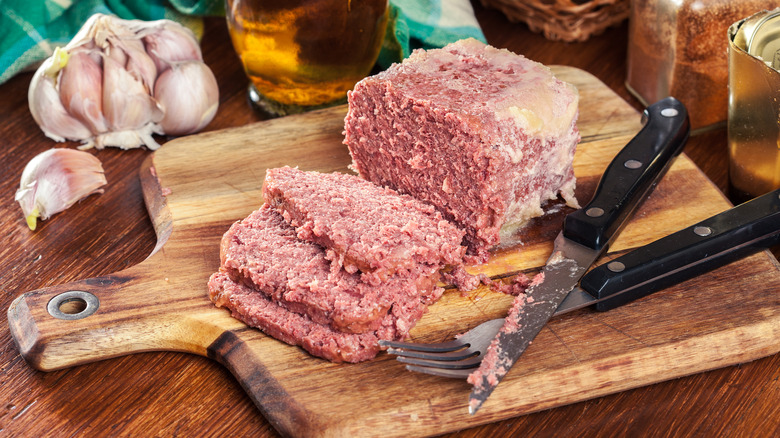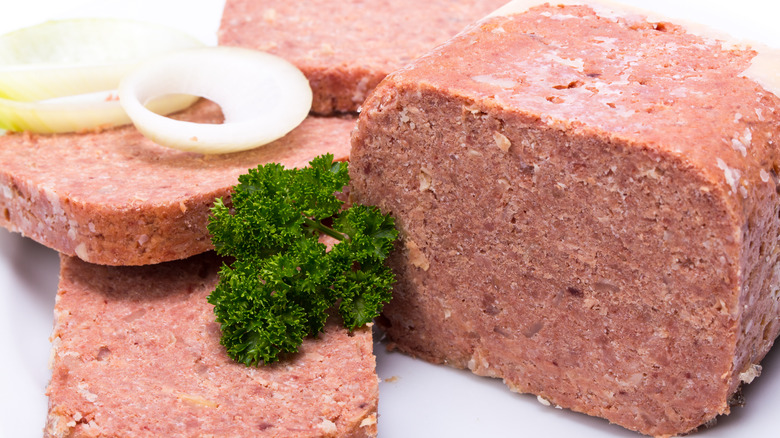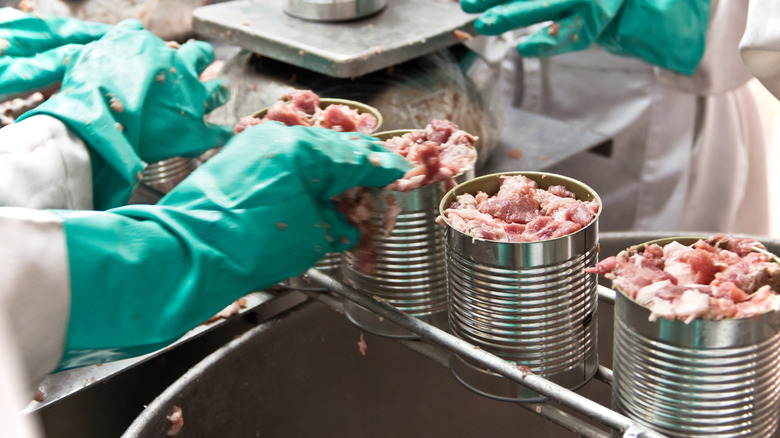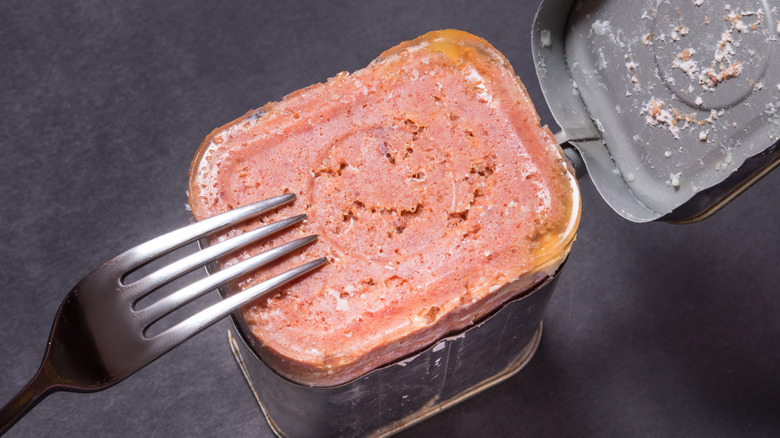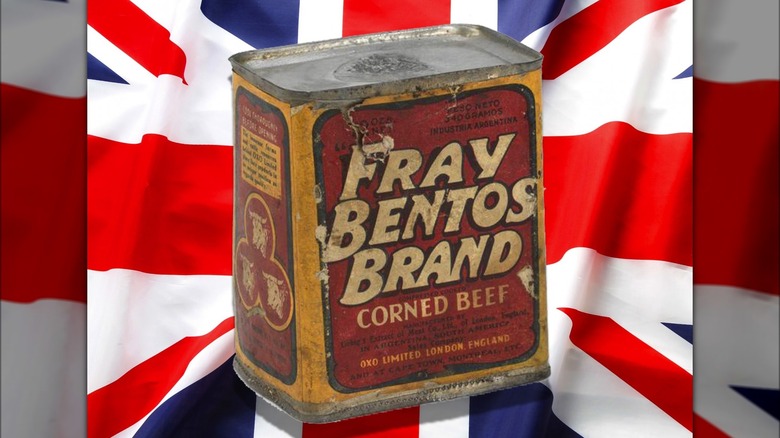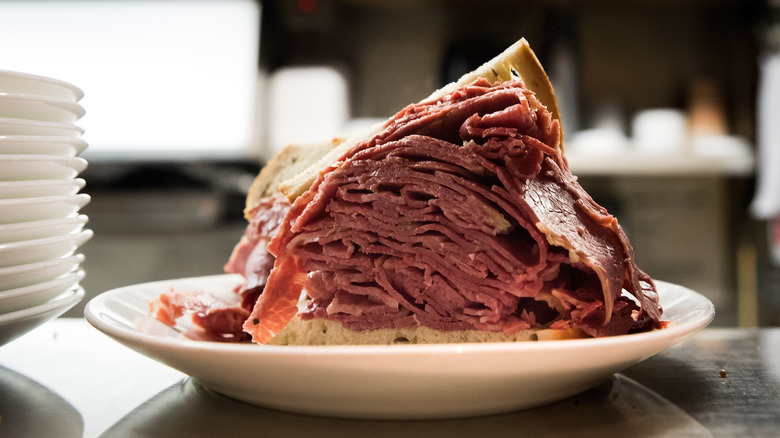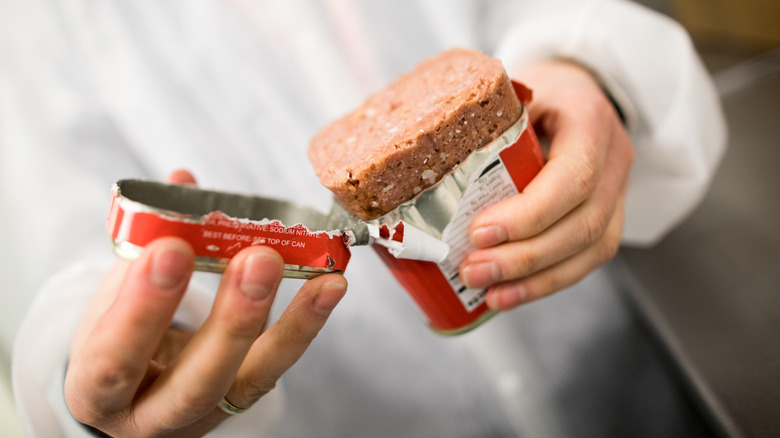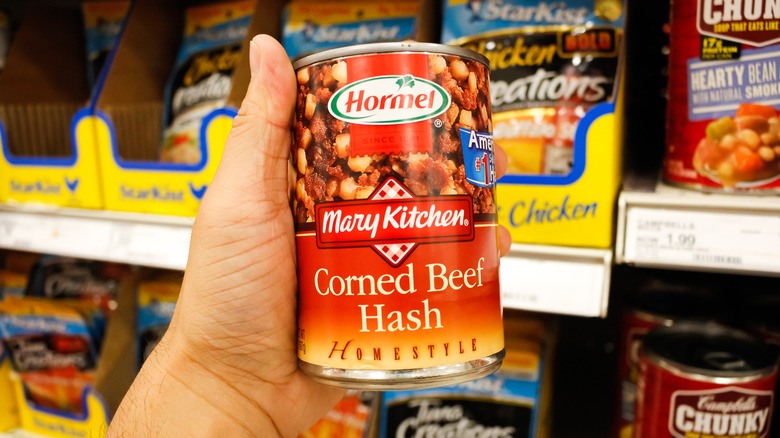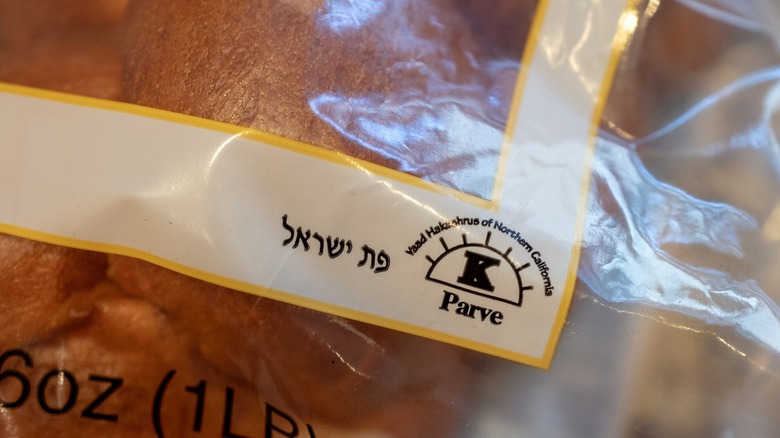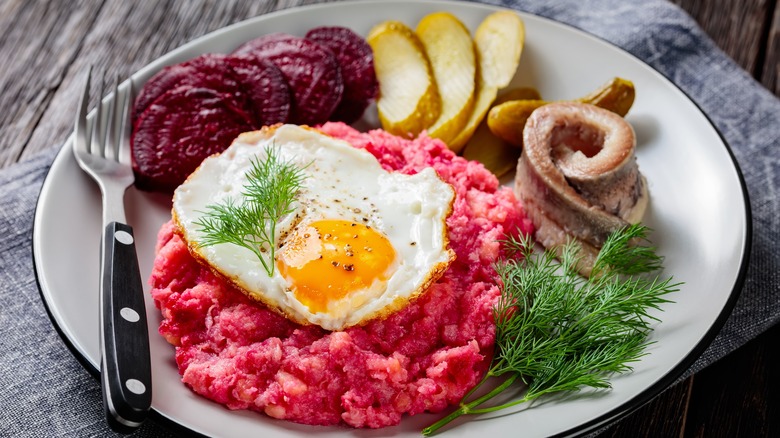What Is Canned Corned Beef And How Is It Made?
In the United States, there are two products you can buy that we call corned beef. One of them you can find on a Reuben sandwich or served over cabbage. The other comes from a can and is found at the supermarket or in a greasy breakfast diner. If you've only had corned beef sandwiches all your life and this comes as a shock to you, don't worry, we are here to get you up to date on canned corned beef, its history, and how its made.
While corned beef has Turkish roots, the tinned variety was popularized by the British military during WWI and WWII. Called "bully beef" at the time, this canned good was a common ration for British and Allied troops during both of the World Wars. Some British troops were even eating this meal up until 2009. With so many men fighting in these wars its no surprise it became a popular in the rest of the country — and overseas — before too long.
So, with that brief history out of the way, let us get down to just what exactly is inside that can of corned beef and how it gets in there in the first place. Here's what you need to know about canned corned beef.
What is canned corned beef made of?
Canned corned beef does not tend to have too many ingredients. Most brands list the main ones as simply beef (or cooked beef), salt, sugar, and sodium nitrite. The latter is a common preservative used in cured meats. Before the beef is canned, it is partially cooked and cured. Large-grain salt pieces the size of corn kernelsare added for curing, hence the name "corned" beef.
The parts of the cattle the beef is taken from are not specified, which has led to speculation and urban myths about the quality of what's inside the can since it could be any part of the animal. We admit, when we see a label that vaguely says "cooked beef" it's not the most encouraging sign. However, it's safe to presume that canned corned beef is made from leaner, cheaper cuts of meat because that is what is what will stay preserved the best when canned.
How is canned corned beef made?
Canned corned beef is produced in a multi-stage process. Canning meats like corned beef and Spam involves cooking, curing, sterilization, and packaging. Here's a quick overview of the process of canning boiled down to its most basic.
First, the meat is cured by one of two methods — either dry or wet curing. The latter is what is most commonly referred to when discussing curing. When curing with a brine, the meat is put in a mixture of salt, sugar, and other spices and herbs (often including bay leaves and coriander) in order to properly preserve it and infuse flavor. The meat soaks in this saline solution for five to seven days before it is cooked for the first time.
The meat is then broken down and put into a can. Once its canned, the beef needs to become sterilized and ready to eat. Sterilization is a crucial a step wherein the cans get heated to a high temperature in order to kill any leftover microorganisms lingering in the beef. After this, the corned beef is safe to eat and ready to be shipped to the store.
Can corned beef be eaten right out of the can?
If you've been paying attention so far you might have picked up on the answer to this one already. Due to the high temperature, high humidity sterilizing process that every can of corned beef needs to go through before hitting store shelves, the contents of the can do indeed get cooked. This means that, yes, canned corned beef is safe to eat straight out of the can if you so please.
This might not be the warmest or tastiest way to consume it, but it is the quickest. Soldiers have been doing it for over a century now, so who are we to say anything to its detriment?
If you want to make a quick sandwich and are craving something meaty, having a can of corned beef on hand could do just the trick. Just slide the hunk out of the can and cut yourself a big slice for dinner. Nobody is stopping you, hypothetical corned beef lover.
Most canned corned beef is made in South America
Now that you know how canned corned beef is made, you might want to know where it is made. As of 2011, over 80% of the world's supply of canned meat was being made in Brazil. The country is still the supplier for most of the largest brands around the globe. If you read the labels on Hormel, Goya, or Great Value brand corned beef you will see its all a product of Brazil. Although the country is still the largest exporter of any type of beef in the world, another South American town might rival it for its historical significance when it comes to corned beef specifically.
Fray Bentos, Uruguay was the original location of all packaging and production of Fray Bentos corned beef until the late 1960s. Today, the brand produces its canned goods in Scotland, but don't let that discount the millions of cans of corned beef that were shipped out from Uruguay between the mid 1800s and the end of the World War II. In 1943, 16 million cans of corned beef were shipped from this port, a majority of them as rations for Allied soldiers.
How is canned corned beef different from fresh corned beef?
The biggest difference between canned corned beef and what we'll call "fresh" corned beef is that the two are made with different cuts of meat entirely. While canned corned beef is made from a mix of beef parts, the non-canned variety is typically made out of brisket. This cut of meat comes from the lower chest of the cow and, if cooked properly, can be one of the most tender sections of beef you can get. As a result, both the flavor and texture of the products are quite different.
The second and most obvious difference between canned and fresh corned beef is how they are cooked. Canned corned beef is cooked during the canning process, while non-canned corned beef can be cooked in a variety of ways. Most commonly, corned beef brisket is slow cooked by braising or boiling. Low and slow is the best way to make that cut of meat come out as tender as possible.
What does canned corned beef taste like?
Unlike its un-canned counterpart, canned corned beef is admittedly a bit of a one-note flavor. What you're going to get primarily with corned beef from a can is salt. The experience of eating canned corned beef can differ depending on how you doctor it up, though.
From the jump, if you eat it straight from the can, you will get a strong salty and meaty bite that tastes more like an all-beef hot dog than a corned beef sandwich. The briny brightness of the corned beef you might be used to from the deli or butcher is absent.
Texturally, corned beef from a can is mushy. It sticks together well enough when cut into slices but its structure is looser than even SPAM, the most similar canned meat out there. If you want more dimension to your meal, that's where reheating canned corned beef comes into play. Even by simply crisping some up in a pan you can add texture and flavor to your meal without using any extra ingredients whatsoever.
How is canned corned beef hash different from canned corned beef?
The go-to use for canned corn beef in the United States is corned beef hash. Commonly, corned beef hash is served alongside eggs, toast, and — if you're lucky — even more potatoes. This savory breakfast staple at Jewish delis and greasy spoon diners nationwide is also sold in a can all on its own, so be sure not to pick that up on accident while shopping for canned corned beef at the grocery store.
If a recipe calls for corned beef, you certainly don't want to use corned beef hash since it will include extra ingredients. A can of Hormel Corned Beef Hash — for example — contains beef, diced potatoes, salt, sugar, flavoring, spices, and sodium nitrite. These extra seasonings and spices make canned corned beef hash an easy breakfast that you don't have to worry about adding anything to — just dump a can into a skillet and heat it up until it hits the desired level of crispiness. Plain canned corned beef, on the other hand, requires a bit more work to become a fully composed meal.
Is canned corn beef Kosher?
This is a tricky question as it doesn't have a definitive answer. It's an important one to discuss, though, since deli corned beef is often made from Kosher beef. Unfortunately, the canned corned beef you'll find at the grocery store is not Kosher and here's why.
In order for a food item to be classified as Kosher it needs to be certified by one of a handful of verified rabbinic agencies. If a grocery store item is Kosher, the packaging will need to make note of that using one of a handful of symbols, depending on which organization certified it. None of the top brands of canned corned beef we could find followed these guidelines nor do any even claim to be Kosher. That doesn't mean a Kosher canned corned beef product never existed, though.
Up until its discontinuation in 2011 the country of Israel had been producing Loof, a kosher alternative to Spam, for decades. The primary purpose for this canned meat was feeding soldiers in the Israeli military, similar to the "Bully Beef" of the British army.
What to cook with canned corned beef
We love corned beef hash as much as the next guy, if not more, but that's only the jumping off point for this ingredient. There is a whole wide world of recipes you can make using canned corned beef.
You can cook it with cabbage in a soup or a stew. Or you can experiment with pairing it with eggs in forms other than a hash. A frittata or a quiche would be quite nice. In Hamburg in Germany, locals are partial to a breakfast known as Labskaus. The dish includes corned beef, a fried egg, beets, potatoes, and pickled herring. It is a bit of a German take on the hash, but it tastes nothing like our American version.
Since the two are so similar, canned corned beef can also be used as a substitute for Spam. In Hawaiian cuisine, it's actually used quite a bit. You can replace the Spam in Spam musubi with a slice of canned corned beef, or make it the base of your next loco moco instead of the traditional hamburger patty or Spam.
